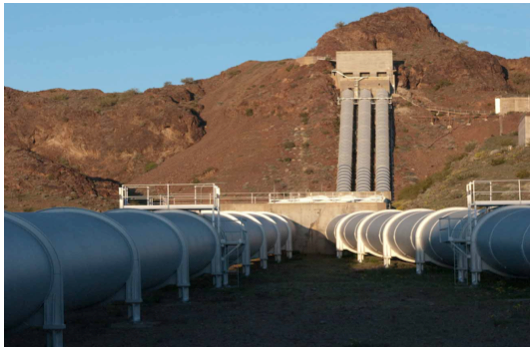CommentsDEEGAN ON CALIFORNIA-The board of the Metropolitan Water District, the mammoth agency that brings water from the Colorado River to lots of Southern California, has announced a $10 million dollar capital campaign as a solution to what had been described as awful living conditions being suffered by their workers -- highlighted by a March 8 petition to MWD Chair Randy Record from three dozen workers asking him to step in about a sewage leak at the Gene camp, one of the desert housing centers. All MWD camps now are slated for major infrastructure improvements in the plan the MWD board just approved.
“We were notified in late February 2017 about leaking waste water pipes under five desert houses, and the problem was addressed immediately,” Jim Green, the manager of MWD’s Water System Operations Group (WSO) told CityWatch.
Green added, “The recent sewage leak validated the approach we were taking upgrading desert housing as part of a comprehensive capital campaign that was unanimously approved by the MWD board last week. We consider desert housing at the same level of importance as the pumps and pipes that transport the water.”
Who knew the MWD was a landlord housing workers in several remote desert camps, built many decades ago and badly in need of the upgrade that is now in the works? The board directors did, and so did the management. Now, they are doing something about it.
And, why are those workers so important in keeping MWD running smoothly? It sounds archaic and reminiscent of “company towns” where workers were forced to endure whatever conditions the employer placed them in, but there’s a reason these workers are located in harsh-conditioned, isolated desert camps.
According to MWD Director Stephen Faessel, to help understand why the housing infrastructure devolved into what some would call “slum-like” conditions, you must take a trip back in time to eighty-six years ago when William Mulholland was assigned to create an aqueduct to carry water from the Colorado River to the Southern California region.
In 1913, Mulholland had already tapped the Owens Valley for water, but the population explosion in Southern California demanded yet more water. The Colorado River Compact gives California a large share of that river’s water and that is what Mulholland went after.
Construction of the 242 mile Colorado River Aqueduct began in 1931 and took eight years and 10,000 men to complete. It has been described by historians as the biggest Depression era public works project in Southern California. It’s a massive engineering feat that is recognized by the American Society of Civil Engineers (ASCE) as one of the "Seven Engineering Wonders of American Engineering.”
The aqueduct pumps more than one billion gallons of water each day through pipes 10 feet in diameter that bring the Colorado River water to Southern California, from Lake Havasu/Parker Dam, the main holding reservoir for the Colorado River Aqueduct, to six counties in Southern California, providing water to more than 19 million people throughout the region (the Los Angeles DWP got 70% of its water from the MWD last year.) It accomplishes this by moving the water through a system of 90 miles of tunnels, nearly 55 miles of cut-and-cover conduit, almost 30 miles of siphons, and five pumping stations. The Gene pumping station, located near Parker Dam, one of the five that lift water up over the mountains, is where the sewage problem was.
The danger of pumping such massive quantities of water is that there may be a harmful “back flow” if the pressure suddenly drops and water is flushed backwards through the system, wreaking havoc on, and potentially destroying, the pumping machinery. The most effective safety valve for this contingency is to have MWD workers live no more than 15 minutes away from the five sets of pumps that service pipes that stretch across the desert from the river to the sea, so they can immediately intervene. Hence, when the pumps and pipes were built, MWD built worker housing to be sure their workers were within the 15 minute call-zone. It’s those tenants, who pay rent to the MWD to live in company housing, that have been living in bad conditions.
Speaking about the $10 million dollar capital campaign that will pay for a major overhaul to upgrade the desert housing conditions at the five pumping plants, MWD’s Green said, “It’s just phase one of our major capital improvement plan.” It could, like MWD Director Brett Barbre said, “make it a paradise so people strive to live there….and say Metropolitan takes care of its people.” Some board members were shocked when they saw pictures of the living conditions and said they did not know about the sewage problem. One MWD board member, Sylvia Ballin, told CityWatch, “I’m really upset about this and distraught.”
(Tim Deegan is a long-time resident and community leader in the Miracle Mile, who has served as board chair at the Mid City West Community Council and on the board of the Miracle Mile Civic Coalition. Tim can be reached at [email protected].) Edited for CityWatch by Linda Abrams.
-cw
Sidebar
Our mission is to promote and facilitate civic engagement and neighborhood empowerment, and to hold area government and its politicians accountable.

 CityWatch Los Angeles
Politics. Perspective. Participation.
CityWatch Los Angeles
Politics. Perspective. Participation.
18
Thu, Dec















